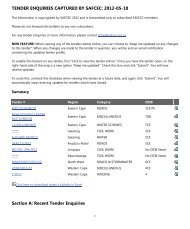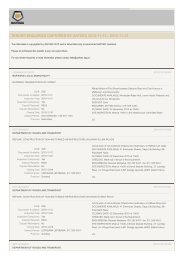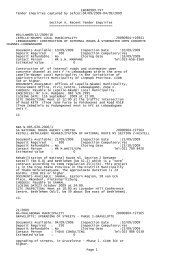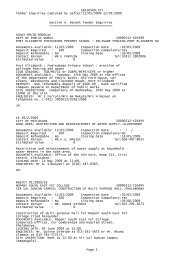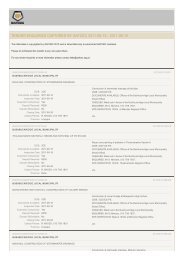DIGEST 2006 - Sabita
DIGEST 2006 - Sabita
DIGEST 2006 - Sabita
Create successful ePaper yourself
Turn your PDF publications into a flip-book with our unique Google optimized e-Paper software.
intensive and time consuming<br />
projects such as deep patch<br />
maintenance are even more<br />
troublesome.<br />
A deep patch maintenance project<br />
in Sydney, Australia, required that<br />
a stretch of road pavement 67<br />
meters long, approximately<br />
400mm deep and 3 meters wide<br />
be removed, profiled and repaved<br />
in four layers within 9 hours —<br />
working at night, in the middle of<br />
winter. No rutting was to be<br />
observed the next morning or<br />
shortly thereafter as a result of<br />
elevated asphalt temperatures.<br />
The road carries a traffic loading of<br />
approximately 60 000 vehicles/<br />
day, and road authority<br />
specifications on compaction, ride<br />
quality etc. had to be met.<br />
Project<br />
requirements<br />
The project<br />
requirements could<br />
only be achieved by<br />
producing and<br />
delivering “warm<br />
mix” asphalt to site,<br />
and laying it at<br />
considerably lower<br />
temperatures than<br />
normal. This was achieved by<br />
modifying the bitumen with FT<br />
wax at 1.5% of the binder<br />
content.<br />
The project started at 20h30 with<br />
the profiling and removing of the<br />
old asphalt and base layers. Once<br />
the area had been cleaned,<br />
200mm of stabilised base was<br />
compacted into the affected area<br />
and finished to ensure that exact<br />
levels were attained. This process<br />
No extraordinary<br />
precautions<br />
were taken<br />
during the<br />
paving or<br />
compaction<br />
processes<br />
lasted until approximately 00h30,<br />
by which time the ambient<br />
temperature had dropped to 10 0 C.<br />
Wind chill effects made workability<br />
and effective compaction even<br />
more difficult.<br />
The asphalt was to be laid in two<br />
base layers of 60mm each, and<br />
two wearing course layers of<br />
45mm each. The 60mm base<br />
layers were produced at 130 0 C,<br />
and the two top layers at 140 0 C.<br />
Paving of the first layer began at<br />
approximately 00h45. In addition<br />
to the low paving temperatures,<br />
the paver burners were also<br />
limited to 120 0 C to minimise<br />
introduction of any extra heat into<br />
the system.<br />
Temperature probes were inserted<br />
into the core of<br />
each asphalt layer<br />
to measure<br />
variations in the<br />
temperature of each<br />
mat throughout the<br />
whole process. The<br />
probes were placed<br />
in the middle of<br />
each layer (probe 1<br />
in the bottom and 4<br />
in the top layers)<br />
and not directly on<br />
top of each other to<br />
make sure that the wires were not<br />
cut during the rolling. The<br />
temperature increase is due to the<br />
subsequent layers being deposited<br />
on top of the underlying<br />
layers.The detailed temperature<br />
profiles in Figure 3 show the core<br />
start temperatures and the time<br />
frames taken to finish all four<br />
layers.<br />
91



